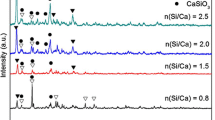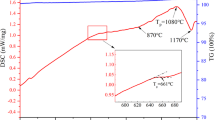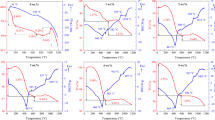Abstract
Heavy metal containing pickling sludge (PS) is one of the by-products of the stainless-steel-making industry, which has been considered hazardous due to contained chromium and nickel. Traditional methods of PS disposing are landfill and cement solidification. This research is aimed at disposing PS by solidification/stabilization and reusing it as a nucleation agent of glass–ceramics. The crystallization behavior and the properties of a glass in the CaO–MgO–SiO2–Al2O3 system were studied by considering PS as the nucleation agent. Experimental results confirm that introducing 14 wt% PS as the nucleation agent of glass–ceramics can decrease crystallization temperature by 110.8 °C, refine the grain size by forming isometric crystals with size of 2 μm, enhance Vickers hardness by 2690 MPa and decrease water absorption from (1.21 ± 0.10) wt% to (0.04 ± 0.01) wt%. Therefore, it is reasonable to conclude that PS can be utilized as a nucleation agent to improve the crystallization and mechanical properties of the glass–ceramics. The testing results of US EPA toxicity characteristic leaching procedure (TCLP) confirm the safety of this reusing method.




Similar content being viewed by others
References
Singhal A, Tewari VK, Prakash S. Characterization of stainless steel pickling bath sludge and its solidification/stabilization. Build Environ. 2008;43(6):1010.
Rögener F, Sartor M, Bán A, Buchloh D, Reichardt T. Metal recovery from spent stainless steel pickling solutions. Resour Conserv Recl. 2012;60:72.
Singhal A, Prakash S, Tewari VK. Trials on sludge of lime treated spent liquor of pickling unit for use in the cement concrete and its leaching characteristics. Build Environ. 2007;42(1):196.
Regel-Rosocka M. A review on methods of regeneration of spent pickling solutions from steel processing. J Hazard Mater. 2010;177(1–3):57.
Nie ZR, Ma LW, ** XL. “Complexation-precipitation” metal separation method system and its application in secondary resources. Rare Met. 2014;33(4):369.
Zhou Y, Zhang QM, Luo J, Tang Q, Du J. Crystallization and dielectric properties of lead-free glass-ceramic composites with Gd2O3 addition. Rare Met. 2012;31(3):281.
Tunali A, Ozel E, Turan S. Production and characterisation of granulated frit to achieve anorthite based glass-ceramic glaze. J Eur Ceram Soc. 2015;35(3):1089.
Garcia-Valles M, Avila G, Martinez S, Terradas R, Nogues JM. Heavy metal-rich wastes sequester in mineral phases through a glass-ceramic process. Chemosphere. 2007;68(10):1946.
Yuan SQ, Dong J, Wang C, Wang ZJ. Comprehensive treating copper tailing and nickel residue. Chin J Rare Met. 2014;38(1):108.
Ghosh S, Pal KS, Dandapat N, Ghosh J, Datta S. Glass-ceramic glazes for future generation floor tiles. J Eur Ceram Soc. 2013;33(5):935.
Zhang K, Liu J, Liu W, Yang J. Preparation of glass–ceramics from molten steel slag using liquid–liquid mixing method. Chemosphere. 2011;85(4):689.
Wang ZJ, Ni W, Jia Y, Zhu LP, Huang XY. Crystallization behavior of glass ceramics prepared from the mixture of nickel slag, blast furnace slag and quartz sand. J Non-Cryst Solids. 2010;356(31):1554.
Vu DH, Wang KS, Chen JH, Nam BX, Bac BH. Glass–ceramic from mixtures of bottom ash and fly ash. Waste Manag. 2012;32(12):2306.
Cheng TW, Chen YS. On formation of CaO–Al2O3–SiO2 glass-ceramics by vitrification of incinerator fly ash. Chemosphere. 2003;51(9):817.
Kim JM, Kim HS. Temperature-time-mechanical properties of glass-ceramics produced from coal fly ash. J Am Ceram Soc. 2005;88(5):1227.
Zhang WY, Gao H, Xu Y. Sintering and reactive crystal growth of diopside–albite glass–ceramics from waste glass. J Eur Ceram Soc. 2011;31(9):1669.
Yang Z, Lin Q, **a J, He Y, Liao G, Ke Y. Preparation and crystallization of glass–ceramics derived from iron-rich copper slag. J Alloy Compd. 2013;574:354.
Karpukhina N, Hill RG, Law RV. Crystallisation in oxide glasses—a tutorial review. Chem Soc Rev. 2014;43(7):2174.
Alizadeh P, Yekta BE, Gervei A. Effect of Fe2O3 addition on the sinterability and machinability of glass-ceramics in the system MgO–CaO–SiO2–P2O5. J Eur Ceram Soc. 2004;24(13):3529.
Abdel-Hameed Salwa AM, Elwan RL. Effect of La2O3, CoO, Cr2O3 and MoO3 nucleating agents on crystallization behavior and magnetic properties of ferromagnetic glass-ceramic in the system Fe2O3·CaO·ZnO·SiO2. Mater Res Bull. 2012;47(5):1233.
Mirsaneh M, Reaney IM, James PF, Hatton PV. Effect of CaF2 and CaO substituted for MgO on the phase evolution and mechanical properties of K-fluorrichterite glass ceramics. J Am Ceram Soc. 2006;89(2):587.
Khater GA. Influence of Cr2O3, LiF, CaF2, TiO2 nucleants on the crystallization behavior and microstructure of glass–ceramics based on blast-furnace slag. Ceram Int. 2011;37(7):2193.
Huang SF, Cao P, Li Y, Huang ZH, Gao W. Nucleation and crystallization kinetics of a multicomponent lithium disilicate glass by in situ and real-time synchrotron X-ray diffraction. Cryst Growth Des. 2013;13(9):4031.
Schmidt B, Wolters R, Kaplin J, Schneiker T, Lobo-Recio MA, López F, López-Delgado A, Alguacil FJ. Rinse water regeneration in stainless steel pickling. Desalination. 2007;211(1):64.
Tang B, Yuan LJ, Shi TH, Yu LF, Zhu YC. Preparation of nano-sized magnetic particles from spent pickling liquors by ultrasonic-assisted chemical co-precipitation. J Hazard Mater. 2009;63(2):1173.
Banijamali S, Eftekhari Yekta B, Rezaie HR, Marghussian VK. Crystallization and sintering characteristics of CaO–Al2O3–SiO2 glasses in the presence of TiO2, CaF2 and ZrO2. Thermochim Acta. 2009;488(1):60.
Mukherjee DP, Das SK. SiO2–Al2O3–CaO glass-ceramics: effects of CaF2 on crystallization, microstructure and properties. Ceram Int. 2013;39(1):571.
Rezvani M, Eftekhari-Yekta B, Solati-Hash** M, Marghussian VK. Effect of Cr2O3, Fe2O3 and TiO2 nucleants on the crystallization behaviour of SiO2–Al2O3–CaO–MgO(R2O) glass–ceramics. Ceram Int. 2005;31(1):75.
Niyompan A, Phumas S, Tipakontitikul R, Tunkasiri T. Phase formation, microstructure and electrical properties of mica glass-ceramics containing Cr2O3 produced by heat treatment. Ceram Int. 2013;39(S1):S427.
Mirhadi B, Mehdikhani B. Crystallization behavior and microstructure of (CaO·ZrO2·SiO2)–Cr2O3 based glasses. J Non-Cryst Solids. 2011;357(22–23):3711.
Wang SM. Effects of Fe on crystallization and properties of a new high infrared radiance glass–ceramics. Environ Sci Technol. 2010;44(12):4816.
Fan CS, Li KC. Production of insulating glass ceramics from thin film transistor-liquid crystal display (TFT-LCD) waste glass and calcium fluoride sludge. J Clean Prod. 2013;57:335.
Acknowledgments
This study was financially supported by the National Natural Science Foundation of China (Nos. 51502014,51472030 and U1360202), the National Key Project of the Scientific and Technical Support Program of China (No. 2012BAC02B01), the National Hi-Tech R&D Program of China (No. 2012AA063202), the Fundamental Research Funds for the Central Universities (No. FRF-TP-15-050A2), and the China Postdoctoral Science Foundation Funded Project (No. 2014M560885).
Author information
Authors and Affiliations
Corresponding author
Rights and permissions
About this article
Cite this article
Yang, J., Zhang, SG., Pan, DA. et al. Treatment method of hazardous pickling sludge by reusing as glass–ceramics nucleation agent. Rare Met. 35, 269–274 (2016). https://doi.org/10.1007/s12598-015-0673-4
Received:
Revised:
Accepted:
Published:
Issue Date:
DOI: https://doi.org/10.1007/s12598-015-0673-4




